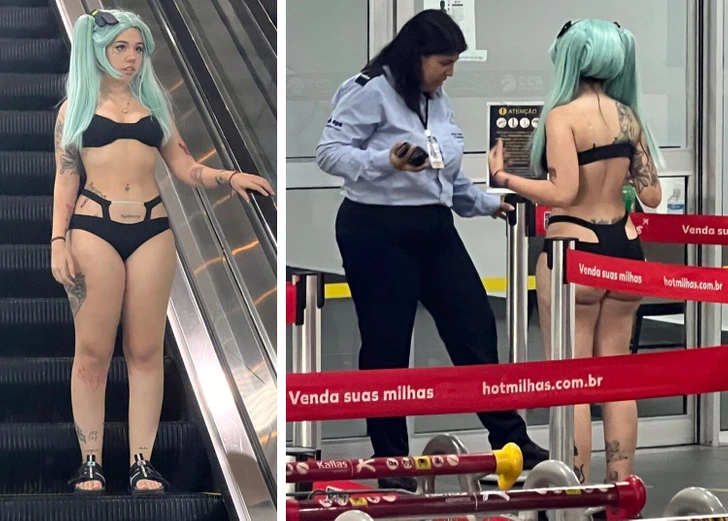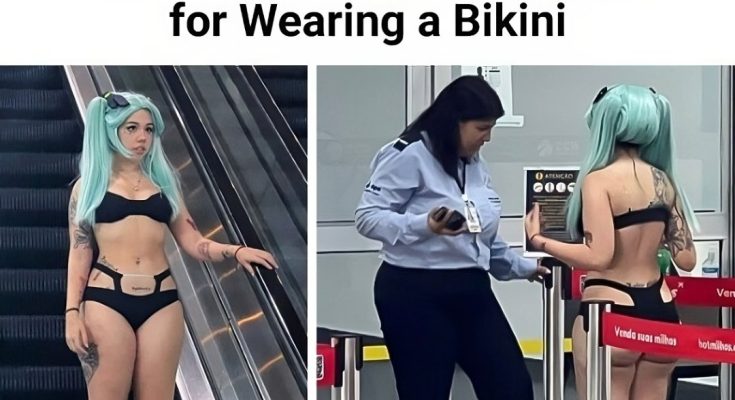A 21-year-old Brazilian model and cosplayer, Kine-Chan, has become the center of an online storm after being denied boarding at Navegantes Airport in Brazil. The reason? Her choice of outfit—a black bikini, paired with a blue wig and black sandals—modeled after Rebecca from the anime series Cyberpunk: Edgerunners. The incident has ignited a fiery debate on social media about freedom of expression, dress codes, and public decency.
Let’s dive into the details of this controversial event, the reasons behind her outfit choice, and the polarizing opinions that followed.

The Incident: Denied Boarding for “Inappropriate” Clothing
Kine-Chan was dressed in cosplay attire to attend an event, intending to head straight from the airport to her room without wasting time changing. However, things didn’t go as planned. When she tried to board her flight at Navegantes Airport, she was stopped by airline staff who deemed her outfit “inappropriate” and refused to let her board until she changed.
Kine-Chan took to Instagram to share her frustration, writing: “A very annoying situation happened this weekend. I tried to board at Navegantes airport dressed as Rebecca’s cosplay for an event. I already knew that I could be late, so I was dressed so as not to waste time. But I was told to go home and change clothes because the one I was wearing was not ‘appropriate.’”
This unexpected turn of events left her frustrated and sparked widespread attention online.
The Controversial Outfit: Cosplay Meets Public Spaces
Kine-Chan’s outfit, inspired by Rebecca from Cyberpunk: Edgerunners, consisted of a revealing black bikini, a blue wig, and casual black sandals. While this look aligns with the character’s style and the cosplay community’s norms, it also challenges traditional dress expectations in public spaces like airports.
Cosplay, short for “costume play,” is a growing form of self-expression in which individuals dress as fictional characters from anime, video games, or movies. For many, it’s an art form and a way to bring their favorite characters to life. However, the bold and revealing nature of some cosplay outfits often pushes societal boundaries, as seen in this incident.

Online Reaction: Divided Opinions on Freedom and Decency
As Kine-Chan’s Instagram post went viral, her fans and followers flooded the comment section with mixed reactions. Some supported her creativity and freedom of expression, while others believed her outfit was inappropriate for an airport setting.
Support for Kine-Chan
Many rallied behind Kine-Chan, praising her artistic talent and calling out what they perceived as discrimination against her cosplay.
- “It’s truly disappointing to find out the airport barred you, a talented artist, because of a cosplay as incredible as Rebecca’s,” one user commented. “Freedom of expression should always be respected.”
- Another added, “You weren’t harming anyone. Creativity and individuality should be encouraged, not policed.”
Supporters highlighted that cosplay is a legitimate form of art and expression and questioned why airports should have the authority to impose subjective dress codes.
Criticism of Her Outfit Choice
On the other hand, some argued that her outfit was not suitable for a public space like an airport, where modesty and practicality are typically expected.
- One commenter wrote, “Kine, I love you, but you could have worn something like a simple pull-over dress or blouse. Airports aren’t cosplay conventions.”
- Another chimed in, “It’s not about creativity—it’s about context. Airports have rules for a reason.”
Critics suggested that while cosplay is a form of expression, it may not always align with societal norms in certain environments, such as airports, where professionalism and appropriateness are often prioritized.
Airline Dress Codes: Where Do We Draw the Line?
The incident raises questions about dress codes and whether airlines should have the authority to enforce them. While dress codes are often vague and subjective, airlines do reserve the right to deny boarding to passengers whose attire is deemed inappropriate or disruptive.
Airline Policies on Dress
Most airlines have policies about dress codes, although they are not always clearly defined. These rules are typically aimed at maintaining a comfortable and respectful environment for all passengers. Clothing that is excessively revealing, contains offensive language, or could potentially disturb others may fall under these guidelines.
In Kine-Chan’s case, the staff’s decision seems to have stemmed from the belief that her outfit was too revealing for a public space, sparking a broader debate on cultural and societal expectations around clothing.
Balancing Creativity and Context
While cosplay is a form of creative self-expression, it’s also important to consider context. Public spaces like airports operate under rules meant to balance individual freedom with collective comfort. The debate here lies in determining whether Kine-Chan’s outfit was disruptive enough to warrant barring her from the flight—or if the airline overstepped.
The Larger Conversation: Expression vs. Etiquette
This incident is not the first time public dress codes have sparked controversy. In recent years, debates about freedom of expression, cultural norms, and personal choice have become more prominent in public discourse. Whether it’s about cosplay, fashion, or personal attire, society continues to grapple with where to draw the line between individual freedom and social expectations.
Cosplay in Everyday Spaces
For cosplayers like Kine-Chan, events like these highlight the challenges of bringing creative expressions into everyday spaces. While cosplay is widely accepted at conventions and events, integrating it into public life often leads to conflicts with societal norms.
Public Perception and Respect
On the flip side, some argue that creative expression should not come at the cost of public decency and respect for shared spaces. Striking a balance between personal freedom and the comfort of others remains a delicate challenge.
A Viral Debate: What This Means for Social Media
As the story gained traction, social media platforms became a battleground for differing opinions. This incident, much like others involving airline etiquette or public decorum, underscores the role of social media in shaping modern debates.
Why It Went Viral
Kine-Chan’s story resonates because it touches on broader issues—freedom of expression, cultural norms, and even feminism. Social media amplified these discussions, turning her personal experience into a global conversation.
The Power of Online Platforms
Platforms like Instagram and Reddit give individuals a voice to share their experiences and spark conversations. Whether users agreed or disagreed with Kine-Chan, her post succeeded in engaging audiences and raising awareness about the challenges faced by creative communities.
Conclusion: Where Do We Go From Here?
Kine-Chan’s story is more than just an incident at an airport—it’s a conversation starter about creativity, freedom, and the boundaries of public decency. While some see her outfit as an act of artistic expression, others view it as inappropriate for the context. Both perspectives hold merit, underscoring the complexity of navigating personal freedom in shared spaces.
As society continues to evolve, these debates will remain essential in shaping our understanding of expression, etiquette, and the ever-changing norms of public life. For now, Kine-Chan’s experience serves as a reminder that creativity often challenges convention—and that’s what makes it so powerful.



